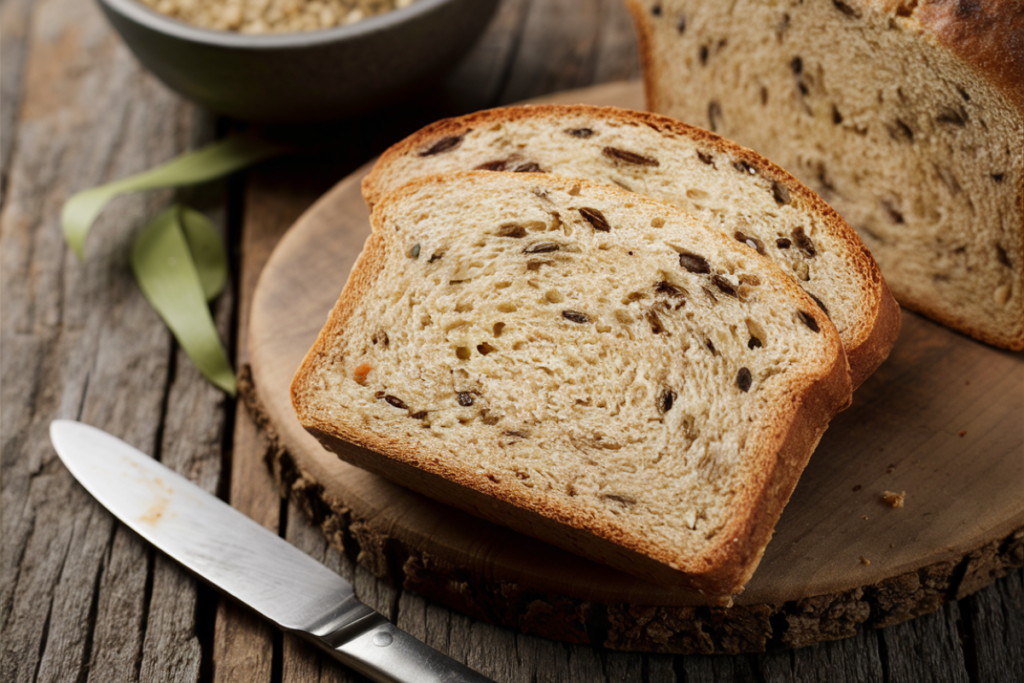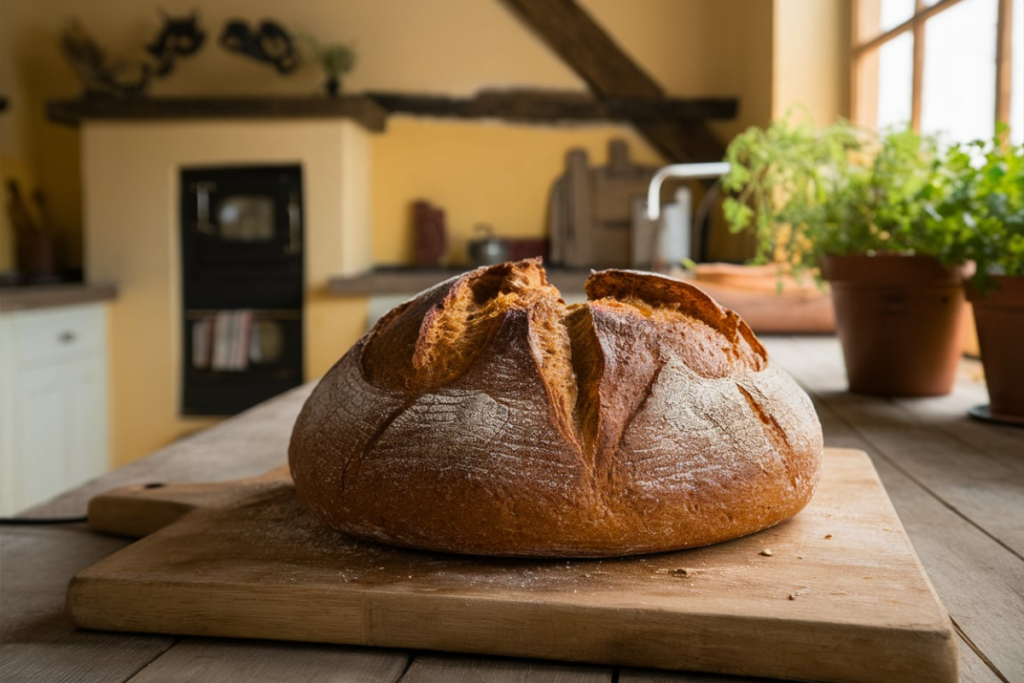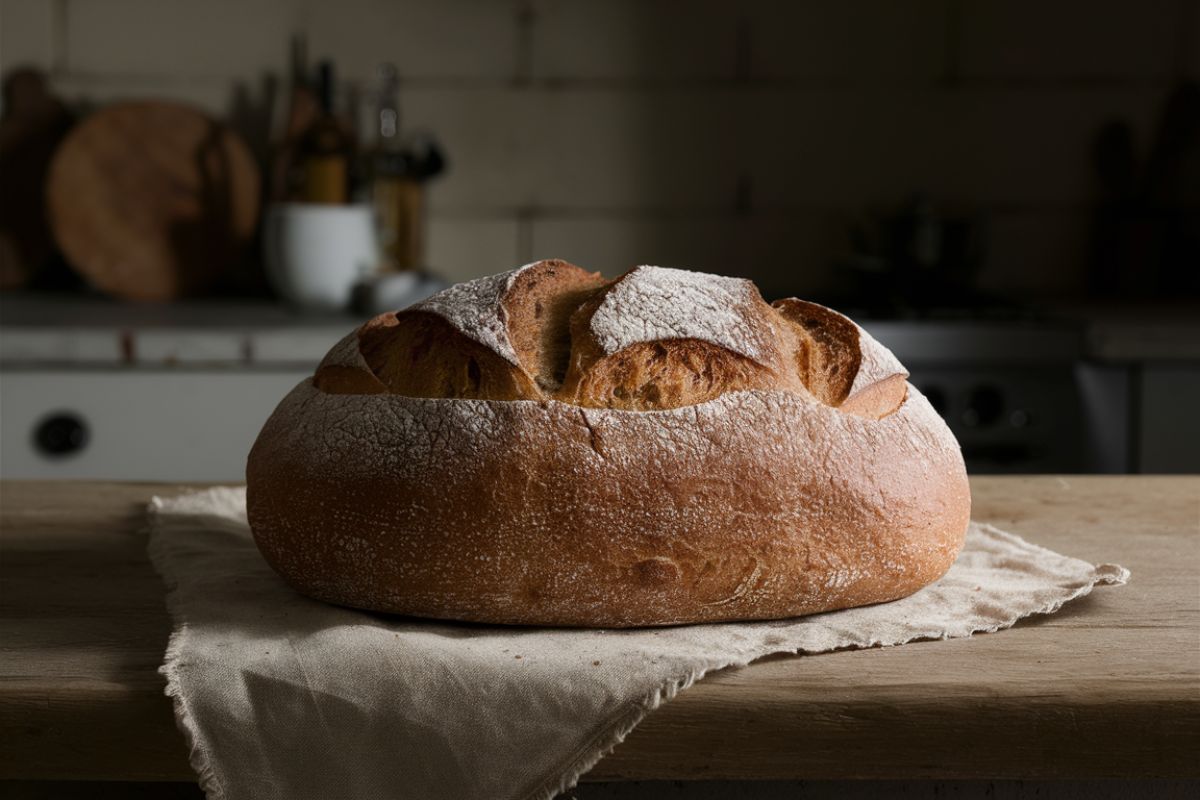🍞 Introduction
Overview of Cottage Bread
Is cottage bread healthy? Cottage bread is a classic and cherished staple known for its rustic round shape and satisfying texture. With its roots in simple, traditional baking, cottage bread has been a comforting and versatile option for many generations. The basic recipe includes flour, water, yeast, and salt, resulting in a hearty loaf that can be enjoyed in various ways—from making sandwiches to soaking up soups. The enduring popularity of cottage bread speaks to its rich culinary history and its place in the hearts of home bakers everywhere.
Relevance of Bread in a Healthy Diet
Bread is a staple in many diets around the world, providing a crucial source of carbohydrates that fuel daily activities. When included in a balanced diet, bread contributes essential nutrients such as fiber, B vitamins, and minerals. As dietary trends shift towards health-conscious choices, understanding the nutritional value of different bread types is important. Evaluating the benefits and drawbacks of breads like cottage bread helps individuals make informed decisions that align with their health goals, ensuring they enjoy their bread while maintaining a healthy lifestyle.
🍞 What is Cottage Bread?
Definition and History
Cottage bread is characterized by its traditional, rustic appearance and hearty, round shape. Originating from an era when bread was a daily homemade necessity, it reflects the simplicity and ingenuity of early bakers. The term “cottage bread” evokes images of homey kitchens where this loaf was baked to nourish families. Its history is intertwined with the evolution of baking practices, making it not just a bread but a symbol of culinary tradition.
Traditional Ingredients
The core ingredients of cottage bread are:
- All-purpose or Bread Flour: Provides the necessary structure and texture.
- Water: Essential for hydrating the flour and activating the yeast.
- Yeast: The leavening agent that causes the bread to rise.
- Salt: Enhances flavor and strengthens the dough.
Optional ingredients for variations include:
- Butter or Milk: For a richer, more tender crumb.
These basic components combine to create a loaf that is both simple and deeply satisfying, making it a favorite for many home bakers.
Variations in Cottage Bread
As baking techniques evolve, so do the variations of cottage bread. Modern bakers often experiment with:
- Whole Grain Flours: Adding nutritional benefits and a denser texture.
- Seeds, Nuts, or Dried Fruits: Introducing new flavors and enhancing the bread’s nutritional profile.
These adaptations cater to various tastes and dietary needs, offering options from classic to innovative. Exploring these variations allows bakers to enjoy cottage bread in numerous ways, reflecting personal preferences and health considerations.
🥖 Nutritional Profile
Macronutrients
Cottage bread primarily provides carbohydrates, essential for energy:
- Carbohydrates: The primary source of energy, making up most of the bread’s caloric content.
- Protein: Present in smaller amounts, contributing to muscle repair and growth.
- Fat: Minimal in cottage bread, contributing to its low-fat profile.
A typical slice contains around 80-100 calories, making it a moderate choice for those managing their caloric intake.
Vitamins and Minerals
Whole grain cottage bread offers several essential nutrients:
- B Vitamins: Important for energy metabolism, red blood cell formation, and brain health.
- Iron: Essential for oxygen transport in the blood and overall energy levels.
- Magnesium: Supports muscle and nerve function, as well as bone health.
- Zinc: Crucial for immune function and cellular repair.
These nutrients contribute to overall health, supporting various bodily functions and enhancing well-being.
Fiber Content
The fiber content in cottage bread depends on the flour used:
- Whole Grain Flour: Provides significant dietary fiber, which aids in digestion, helps maintain healthy blood sugar levels, and supports weight management.
Whole grain breads like cottage bread are valuable sources of fiber, promoting digestive health and contributing to a balanced diet.
🥗 Health Benefits

Is cottage bread healthy?
Role of Whole Grains
Including whole grains in your diet, like those found in cottage bread, offers various health benefits:
- Reduced Risk of Chronic Diseases: Whole grains are associated with a lower risk of heart disease, type 2 diabetes, and certain cancers.
- Sustained Energy Release: Whole grain carbohydrates provide a steady energy release, supporting long-term health and vitality.
Incorporating whole grains into your diet can contribute to better health outcomes and increased energy levels.
Impact on Digestive Health
The fiber in whole grain cottage bread plays a crucial role in:
- Promoting Regular Bowel Movements: Helps prevent constipation and supports a healthy digestive tract.
- Feeding Beneficial Gut Bacteria: Acts as a prebiotic, fostering a balanced gut microbiome and enhancing overall gut health.
A healthy digestive system is essential for overall well-being, and the fiber in breads like cottage bread supports this important aspect of health.
Benefits for Heart Health
Whole grain cottage bread supports heart health by:
- Cholesterol Reduction: Helps lower LDL (bad) cholesterol levels, reducing the risk of heart disease.
- Cardiovascular Support: Variants with seeds or nuts provide additional healthy fats, which are beneficial for heart health and overall cardiovascular function.
A heart-healthy diet that includes nutrient-rich bread options can contribute to long-term cardiovascular health.
🍞 Cottage Bread vs. Other Breads
Comparison with White Bread
Cottage bread and white bread differ significantly in:
- Flour Type: White bread is made from refined flour, which removes the bran and germ from the wheat, leading to a loss of nutrients and fiber. Cottage bread, especially when made with whole grains, retains these components, providing more fiber, vitamins, and minerals.
- Nutritional Value: The higher fiber content in cottage bread contributes to better digestive health and may help regulate blood sugar levels. White bread often lacks these benefits due to its refined nature.
Choosing whole grain alternatives like cottage bread over white bread can offer improved nutritional benefits and support a healthier diet.
Comparison with Whole Wheat Bread
Whole wheat bread and whole grain cottage bread share many similarities:
- Nutritional Profile: Both types are made from whole grains and offer a rich source of fiber, vitamins, and minerals. They are generally healthier than white bread.
- Preparation Style: Cottage bread may appeal to those who enjoy a more traditional, artisanal approach to baking. Whole wheat bread is often mass-produced, which may not capture the same homemade quality.
Whole grain cottage bread provides similar health benefits to whole wheat bread while offering a unique texture and flavor.
Comparison with Gluten-Free Bread
Cottage bread is not suitable for gluten-free diets unless specifically made with gluten-free ingredients:
- Gluten Content: Traditional cottage bread contains gluten, a protein found in wheat and related grains. Gluten-free bread, made from alternative flours like rice, almond, or oat, is necessary for those avoiding gluten.
- Special Considerations: Always check labels to ensure the bread is gluten-free if you have gluten intolerance or celiac disease.
For those with gluten sensitivities, exploring alternative bread options ensures dietary needs are met while still enjoying bread.
⚖️ Is Cottage Bread Good for Weight Loss?
Caloric Content
- Calories per Slice: Cottage bread contains around 80-100 calories per slice, which is moderate compared to other bread types. Managing portion sizes is important to avoid excessive calorie intake.
Satiety and Weight Management
- Fiber: The fiber in whole grain cottage bread helps promote a feeling of fullness, which can aid in appetite control and weight management.
- Pairing: Combining cottage bread with protein-rich foods, such as lean meats or plant-based proteins, can enhance satiety and support weight management goals.
Using whole grain bread options like cottage bread as part of a balanced diet can support weight management and overall health.
⚠️ Potential Drawbacks
Gluten Content
- Suitability: For individuals with gluten sensitivities or celiac disease, cottage bread is not a suitable option unless made with gluten-free flour. For the general population, moderate consumption is generally safe.
Sodium Levels
- Sodium Content: Bread can be high in sodium due to added salt. Those monitoring their sodium intake should read labels carefully or make bread at home to control salt levels.
Monitoring sodium intake in daily bread consumption is important for maintaining heart health and overall well-being.
Presence of Additives
- Additives: Commercially produced cottage breads might contain preservatives, emulsifiers, or sweeteners. To avoid these, opt for bread with a short ingredient list or bake your own at home.
Choosing bread with minimal additives ensures a healthier option and better control over ingredients.
🏡 How to Make Healthy Cottage Bread at Home

Ingredients to Use
For a nutritious cottage bread, gather:
- Whole Grain Flour: Provides fiber and essential nutrients.
- Water: Hydrates the flour and activates the yeast.
- Yeast: Ensures the dough rises properly.
- Salt: Enhances flavor and strengthens the dough.
- Optional Additions: Seeds (like flax or chia), nuts (such as walnuts or almonds), or dried fruits (like raisins or cranberries) can be added for extra flavor and nutrition.
Step-by-Step Recipe
- Prepare the Dough 🥄
In a large bowl, combine 3 cups of whole grain flour with 1 cup of warm water. Stir until the mixture is well combined. - Add Yeast and Salt 🌾
Add 1 packet of yeast and a pinch of salt to the flour mixture. Stir until a dough begins to form. - Knead the Dough 🤲
Turn the dough onto a floured surface and knead for about 10 minutes until it becomes smooth and elastic. This helps develop the dough’s structure. - First Rise ⏳
Place the dough in a lightly greased bowl, cover it with a damp cloth, and let it rise in a warm place for 1 hour, or until it has doubled in size. - Shape and Second Rise 🏺
Punch down the dough to release air, then shape it into a round loaf. Place it on a baking sheet, cover, and let it rise for another 30 minutes. - Bake 🔥
Preheat your oven to 375°F (190°C). Bake the loaf for 30-35 minutes, or until the crust is golden brown and sounds hollow when tapped. - Cool ❄️
Allow the bread to cool on a wire rack before slicing. This helps prevent it from becoming soggy.
Tips for Best Results
- Use Fresh Ingredients: For the best flavor and rise, use fresh yeast and high-quality flour.
- Allow Proper Rising: Adequate rising time is crucial for a light and airy texture.
- Experiment with Additions: Adding seeds or nuts can enhance both flavor and nutritional value. Try different combinations to find your favorite.
👩⚕️ Expert Insights Is cottage bread healthy?
Nutritionist’s Perspective
Nutritionists often recommend whole grain breads like cottage bread as part of a balanced diet due to its high fiber content and essential nutrients. It should be consumed in moderation, especially by those managing weight or blood sugar levels, as part of a varied and balanced diet.
Baker’s Tips on Healthy Bread
- Ingredients Quality: High-quality, fresh ingredients make a significant difference in taste and texture.
- Flour Variety: Experiment with different whole grain flours to find the best flavor and texture for your bread.
- Avoid Over-Kneading: Knead just enough to develop the dough’s structure. Over-kneading can result in a denser crumb.
🍽️ Practical Applications
Incorporating Cottage Bread into Meals
- Sandwiches: Perfect for making wholesome and satisfying sandwiches.
- Breakfast: Toast with avocado or eggs for a nutritious start to your day.
- Sides: Serve alongside soups, stews, or salads for a hearty addition to your meal.
Pairing Suggestions
- Healthy Toppings: Top with hummus, avocado, lean meats, or cheese for a balanced and nutritious meal.
- Snacks: Enjoy with fresh vegetables or a light spread of nut butter for a quick and satisfying snack.
❓ Frequently Asked Questions (FAQs) Is cottage bread healthy?
Is cottage bread gluten-free?
No, traditional cottage bread contains gluten. However, gluten-free versions can be made using alternative flours like almond or rice flour.
Can cottage bread be part of a keto diet?
Cottage bread is not suitable for a keto diet due to its carbohydrate content. Keto-friendly breads typically use almond or coconut flour.
How does cottage bread compare to sourdough?
Cottage bread uses commercial yeast for leavening, while sourdough relies on natural fermentation. Sourdough has a tangy flavor and may be easier to digest due to its natural fermentation process and potentially lower gluten content.
Can I freeze cottage bread?
Yes, cottage bread can be frozen. Slice it before freezing for convenience. Wrap it tightly to prevent freezer burn.
How long does cottage bread stay fresh?
Cottage bread is best enjoyed fresh but can be stored for about 3-5 days in an airtight container at room temperature. For longer storage, freezing is recommended.
